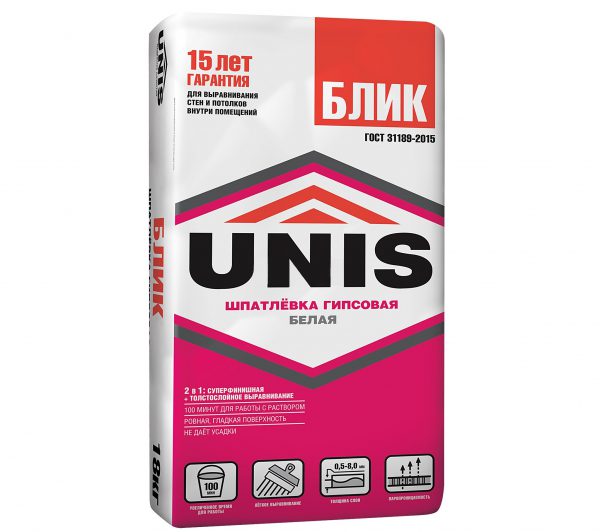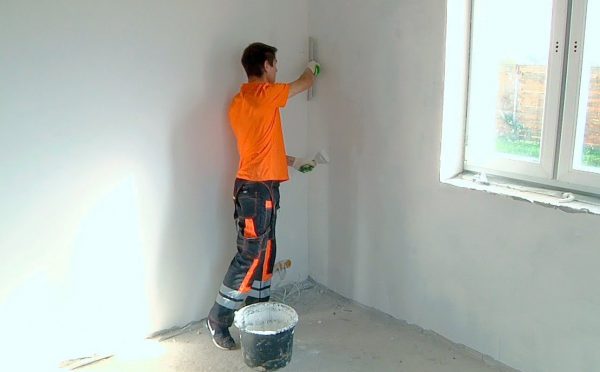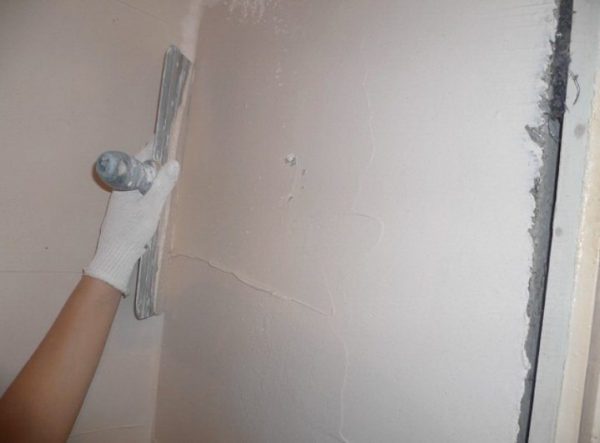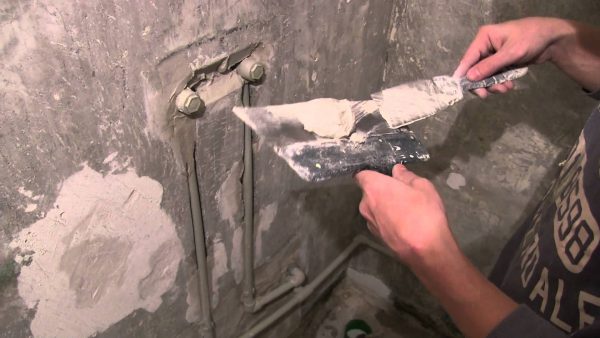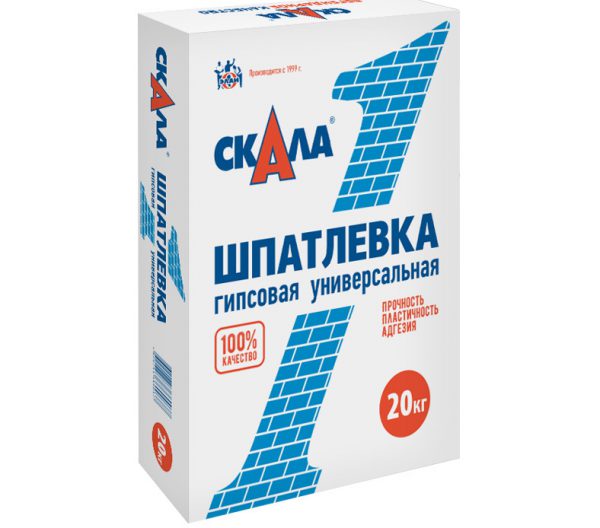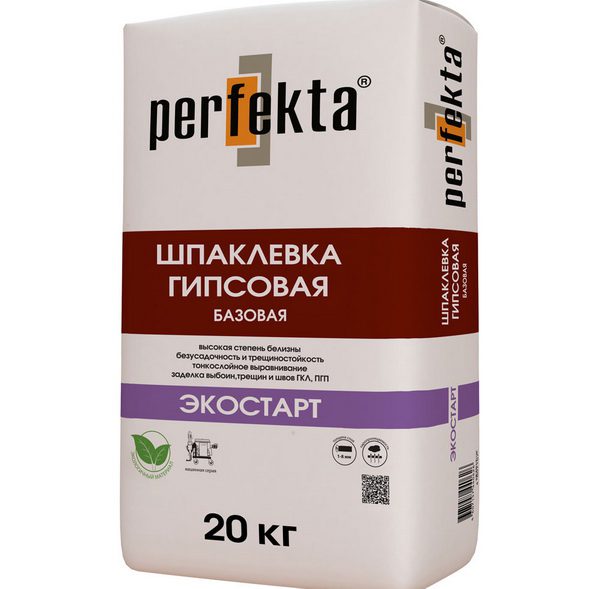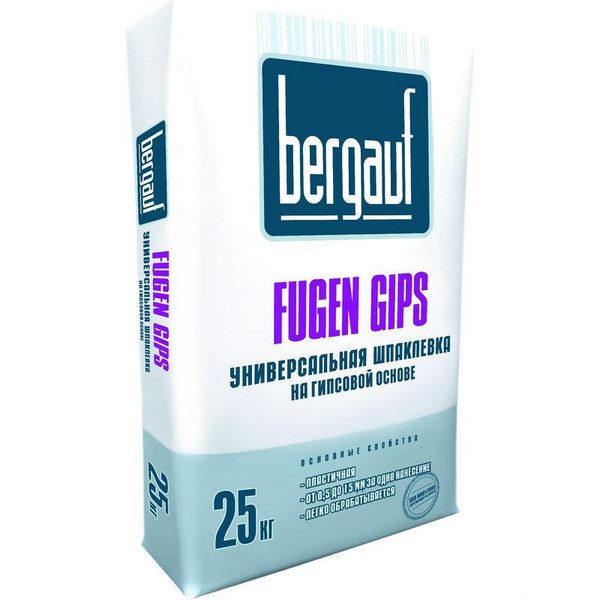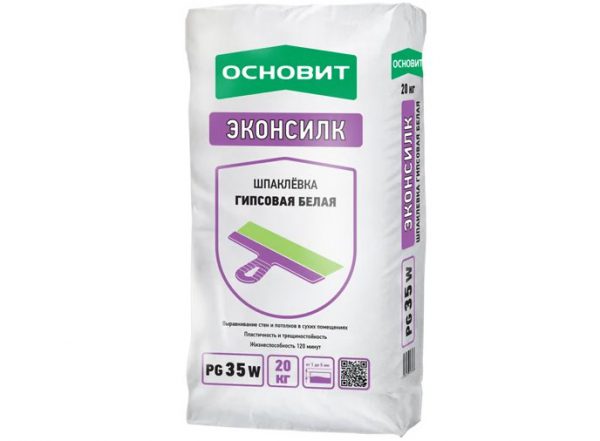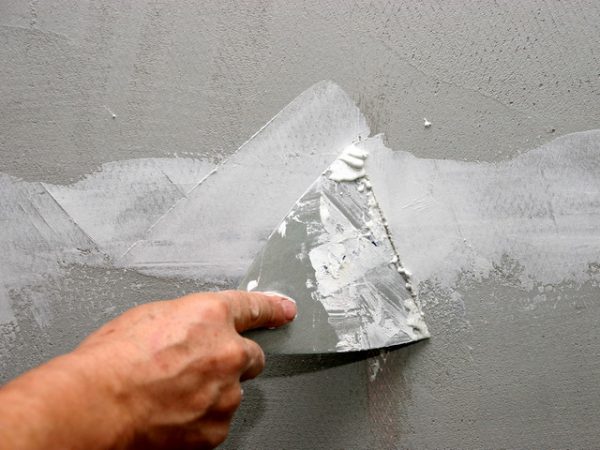Gypsum putty for professionals is a synonym for the concept of “putty”. This material is used to repair walls and ceilings more often than others, because it has all the necessary properties and reliably closes defects, perfectly levels the surface. There are different types of gypsum putty, there is a special technology for its application.
- Features and purpose of gypsum putty
- Scope of application
- Advantages and disadvantages
- Types, composition and characteristics
- Starting putty
- Finishing putty
- Universal putty
- Preparation and application
- Preliminary work
- Solution preparation
- Putty application
- Popular brands
- Safety precautions
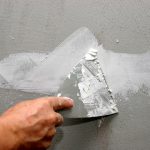
Features and purpose of gypsum putty
By gypsum plaster (putty) is understood a dry or ready (pasty) mixture, which is based on gypsum. Usually, snow-white gypsum is used to develop more expensive products; for those that are cheaper, they are yellowish. Also, materials include modifying additives of various water-soluble polymers, mineral fillers. As the latter, white quartz sand or mineral flour and other components are used. Polymers provide protection against premature drying, cracking and shedding of material.
The size of the additive fraction determines the properties of the putty and the type of its use. The smaller the fraction, the thinner the finished layer will be when applied to the base. Usually the lightest, weightless putties are made on the basis of marble flour of very fine grinding (particle size - tenths of a millimeter). A good putty allows you to grind the surface to a shine, make it very smooth, while using less material.
to contents ↑Scope of application
By most means, only walls and indoor ceilings can be putty. Only mixed materials (with acrylic, latex) are able to withstand the action of aggressive environmental factors, therefore they are also used outside the houses. Typically, gypsum putty levels the walls for subsequent finishing - for painting and sticker wallpaper. Thanks to its excellent adhesion, putty can be used for:
- sealing ceilings, wall seams;
- grouting of various defects and errors;
- filling holes and cracks;
- sealing joints between sheets of drywall;
- eliminate chips.
After using gypsum putty, any surface will become even, smooth to the touch and in appearance. From this mixture you can also make panels, stucco moldings, and decorations for the interior. But we must remember that it is incompatible with chipboard, stone and brick. OSB plate (OSB) can be processed with this putty, but only after preliminary preparation and thorough priming. Also, it is impossible to use a gypsum-based mortar in the bathroom, sauna, pool - the finish will absorb moisture and quickly lose strength.
to contents ↑Advantages and disadvantages
What material is better to use for leveling and how the gypsum mixture stands out among the analogues - we will consider further.
Comparing polymer acrylic putty with gypsum, you can find a lot in common. Both of them:
- designed to seal cracks, seams, effective alignment of even complex surfaces;
- easy to apply, perfectly level;
- have an elastic texture, white color.
Nevertheless, there is a difference. Gypsum material, unlike polymeric, is vapor permeable. It does not violate the microclimate in the room, does not provoke the appearance of a fungus. Acrylic and latex allow less air to pass through, more resistant to moisture, therefore they are often recommended for outdoor use, facade work. Some polymer putties have artificial ingredients, while gypsum is almost 100% natural.
Other advantages of gypsum material are as follows:
- favorable price, economical consumption (1 m2);
- environmental friendliness, does not emit toxins;
- the ability to be applied to different surfaces, excellent compatibility with other putties by the second layer (even based on cement);
- high adhesion;
- lack of separation, cracking, shedding, shrinkage after drying over a long period;
- ease of puttying and subsequent grinding;
- strength of the finished layer;
- aesthetic appearance.
The material has few disadvantages, but they are. The product must be properly diluted, otherwise the risk of lumps and spoilage of the entire mass is high. The finished solution does not cost long - it must be applied quickly, until it has frozen, it will not be possible to dilute the product again. The storage period of a dry mixture usually does not exceed 6-12 months, while polymer putties are stored for several years.
Also a big minus is the high hygroscopicity. It is not allowed to use the material in humid rooms, at regular temperature differences. It is better to use putty on gypsum in the living room, bedroom, study, office and other rooms with normal and low humidity.
to contents ↑Types, composition and characteristics
In accordance with the accepted standards, all putties are divided into starting, finishing and universal. They differ in characteristics and properties, fillers and particle size. But as part of any product there is gypsum and polymer additives, thanks to which the putty dries quickly, the treated surface is durable and smooth. Often such substances are called gypsum polymers, they give the coating:
- plastic;
- elasticity;
- bending strength;
- resistance to cracking.
Usually putties are available in packages of 5-50 kg, less often you can find cans and buckets with a ready-made mass (diluted with water) of 5, 10, 20 liters. Most putties are white, but there are also grayish ones, the most expensive ones are snow-white. The characteristics of the funds vary depending on their type and manufacturer. The average technical indicators of materials are as follows:
- operating temperature range - from +5 to +30 degrees;
- total layer thickness without the use of reinforcing mesh, tape - 10 mm;
- proper dilution: for 1 part of dry powder - 0.5 parts of water;
- setting time - 1 hour;
- complete drying time - 5 hours or more;
- time to set final strength - 7 days;
- consumption - 1-1.4 kg / 1 m2.
How much the solution dries, its consumption and other technical information should be clarified on the packaging.
to contents ↑Starting putty
Such material is often referred to as plaster mixes. Its main purpose is the alignment of walls and ceilings, the sealing of large defects, the elimination of serious level fluctuations, the fixation of devices for undergrowths. Usually, the plaster is smoothed and smoothed with a starting putty, and in new homes it is used as the first layer or after the primer.
To save money, you can buy a basic mixture of gray, it is much cheaper. It is necessary to apply the product with a not very thick layer, and with significant differences - use reinforcing coatings. Without the latter, a layer of dried material will simply fall off. The most serious pits and defects are better to be completely covered with cement plasters.
to contents ↑Finishing putty
This composition helps to form a flat surface for finishing. Usually, finishing putties are applied in 1 layer, creating a smooth white coating. It can be pasted with wallpaper, painted, even in bright colors. In appearance, the finish coating differs from the starting one in greater smoothness (due to the absence of large particles) and whiteness.
Universal putty
There are universal putties (start-finish), which have unique properties.They can be applied in a thick layer with a minimum particle size. The scope is wide - sealing joints on drywall, eliminating cracks and deformations, aligning any bases. Such funds have a snow-white tint and do not require the application of a finishing putty.
to contents ↑Preparation and application
Before using gypsum material, it is important to familiarize yourself with the sequence of actions and strictly observe the rules for preparing the base and mortar.
Preliminary work
All coatings on which the putty will be applied must be clean. Dirt, dust, stains are removed. A vacuum cleaner must be used to clean cracks and cavities, it will allow you to quickly remove even small particles. After that you need to use a deep penetration primer - it will improve the adhesion of the putty to the base.
Solution preparation
The instructions always describe in detail the process of preparing the building mixture, if it is sold in dry form. Tools and kneading container must be clean. The algorithm of actions is as follows:
- pour the right amount of water into the dishes;
- add the powder in small portions (it is best to pour it by hand, so the distribution across the water will be uniform);
- as the powder exceeds the water level, wait 2 minutes to soak the mixture;
- stir the mass manually, but better - using a construction mixer or a drill with a nozzle (at low speeds);
- if the consistency of the mass is liquid, there is no need to rush with the addition of a new portion of powder - after a couple of minutes the mass will thicken.
A large amount of solution should not be prepared immediately. Its shelf life is limited, the mass will harden and deteriorate.
to contents ↑Putty application
To work, you need several spatulas of different sizes. With the help of small take the mass and put it on a large spatula. Then, with smooth, smooth movements, smears are performed on the ceiling or wall. The tool must be held at an angle of 50-60 degrees to the surface, evenly pressing the base.
The thickness of one layer should not be higher than 5-8 mm for the starting layer. The direction of movement on the walls is from the bottom up, on the ceiling - towards yourself. If necessary, apply a reinforcing mesh. If the layer is more than 1.5 cm, it is better to use a galvanized tape, which is screwed with dowels. The applied smears are leveled by subsequent movements of the spatula.
After the first layer has hardened, the second is performed, and so on until a smooth surface is obtained. Last make the finish layer. After the final hardening, the putties are ground with sandpaper attached to the bar. After the wall or ceiling, you can primer and proceed to the final finish.
to contents ↑
Popular brands
For craftsmen, the quality factor is the name of the putty manufacturer. A good product is one that matches the declared properties and allows you to smooth any surface without much effort.
On the market you can find both respectable brands and products of young foreign and domestic companies. It is important to buy a product with an expired shelf life, made according to GOST or other standards - this increases the likelihood of obtaining high-quality putty.
Popular gypsum based products are:
- Knauf (Knauf) - includes a whole line of high-quality products. This includes Uniflot for drywall joints, Fugen for any interior work, Fugen GV for GVL, GKL, HP Finish for any base. The line also includes funds from Rotband Finish, Fugen Hydro, Fugenfüller, Satengips. The last specified putty is also suitable for outdoor use.
- Volma Arctic - a white finishing putty, has increased adhesion to any substrate. Able to completely dry in just 5 hours.
- Econsilk PG35 W is a non-shrinking putty that can be used to repair any joints and cracks, and can also be used for leveling.
- Founded - suitable for sealing joints, joints, large and medium cracks, suitable only for internal work. Very crack resistant.
- Axton - in the mixture there is gypsum of a very small fraction, coupled with elements for strong adhesion and enhanced ductility. The drying time of the mixture on the walls and ceiling is 20 hours.
- Forman 21 is the finishing material for rooms with low and medium humidity. Requires a minimum of water for breeding.
- Bergauf - a line of non-shrink putties with high resistance to cracking.
- Barkraft Universal– is used for grouting with reinforcing tape. Allows you to close even the largest defects.
- Perfect Ecostart - gypsum-polymer leveling putty, excellent sanding, has a high hiding power.
- Runit is a universal interior putty, finely dispersed, it is easily skinned and smoothed.
- EKK200 Chemical - used for thin-layer leveling of concrete, cement, foam concrete, gypsum and gypsum plasterboards. It is used only in dry rooms, it is recognized as high-strength and very plastic.
- Unis flare is a universal basic putty, freezes in 150 minutes, does not shrink.
Also among beginners and professionals the putties “Hercules”, “Staratel”, “Universal” from “Gypsopolymer” in 25 kg bags, as well as 5 and 15 kg found their application.
to contents ↑Safety precautions
When applying building mixtures, and especially when sanding, you need to protect your eyes with glasses, respiratory organs with a respirator. Do not smoke indoors, work without proper ventilation, in an airtight room. After the repair is completed, hands and tools should be thoroughly washed, since cleaning the plaster mixture completely hardens. Compliance with safety measures will make it possible to carry out repairs not only qualitatively, but also without harm to health.

